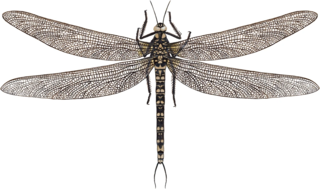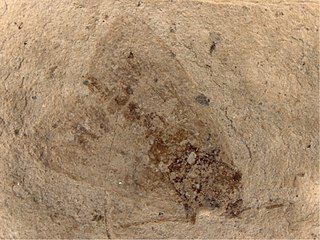
Meganeura is a genus of extinct insects from the Late Carboniferous. They resembled and are related to the present-day dragonflies and damselflies, and were predatory, with their diet mainly consisting of other insects. The genus belongs to the Meganeuridae, a family including other similarly giant dragonfly-like insects ranging from the Late Carboniferous to Middle Permian. With a wingspan ranging from 65 cm (25.6 in) to over 70 cm (28 in), M. monyi is one of the largest-known flying insect species.

Meganisoptera is an extinct order of very large to gigantic insects, informally called griffinflies. The order was formerly named Protodonata, the "proto-Odonata", for their similar appearance and supposed relation to modern Odonata. They range in Palaeozoic times. Though most were only slightly larger than modern dragonflies, the order includes the largest known insect species, such as the late Carboniferous Meganeura monyi and the even larger early Permian Meganeuropsis permiana, with wingspans of up to 71 centimetres (28 in).
Namurotypus is an extinct genus of griffinfly with a single described species Namurotypus sippeli. It inhabited the large swamps of the Carboniferous period. Namaurotypus had a 15 cm long forewing and did not have secondary male sex organs as in modern dragonflies.

Archiinocellia is an extinct genus of snakefly in the family Raphidiidae known from Eocene fossils found in western North America. The genus contains two species, the older Archiinocellia oligoneura and the younger Archiinocellia protomaculata. The type species is of Ypresian age and from the Horsefly Beds of British Columbia, while the younger species from the Lutetian Green River Formation in Colorado. Archiinocellia protomaculata was first described as Agulla protomaculata, and later moved to Archiinocellia.
Proraphidia is a genus of snakefly in the extinct family Mesoraphidiidae. The genus currently contains three species; Proraphidia gomezi from the La Pedrera de Rúbies Formation in Spain, Proraphidia hopkinsi from the Weald Clay in England, and the type species Proraphidia turkestanica from Kazakhstan. The genus was first described by O. M. Martynova in 1941 with the publication of P. turkestanica from Jurassic deposits of the Karabastau Formation in Karatau, Kazakhstan.

Allorapisma is an extinct genus of lacewing in the moth lacewings family Ithonidae. The genus is solely known from two Eocene fossils found in North America. At the time of description the genus was composed of a single species, Allorapisma chuorum.

Paleolepidopterites is a collective genus of fossil moths which can not be placed in any defined family. The included species were formerly placed in the leaf-roller family Tortricidae and are known from fossils found in Russia and the United States. The collective genus contains three species: Paleolepidopterites destructus, Paleolepidopterites florissantanus, and Paleolepidopterites sadilenkoi, formerly placed within the genera Tortrix and Tortricites respectively. The three species were formally redescribed and moved to the new collective genus by Heikkilä et al (2018).

Neurosymploca? oligocenica is an extinct species of moth in the family Zygaenidae, and possibly in the modern genus Neurosymploca. The species is known from Early Oligocene, Rupelian stage, lake deposits near the commune of Céreste in the Alpes-de-Haute-Provence, France.
Dominickus is an extinct genus of moth in the butterfly-moth family Castniidae containing a single species Dominickus castnioides. The species is known from late Eocene, Priabonian stage, lake deposits near the small community of Guffey in Teller County, Colorado, United States.
Epiborkhausenites is an extinct genus of moth in the concealer moth family Oecophoridae and containing a single species Epiborkhausenites obscurotrimaculatus. The species is known only from Middle Eocene, Bartonian stage, Baltic amber deposits near the town of Palanga in Lithuania.
Sinomeganeura is an extinct genus of griffinfly in the family Meganeuridae and containing a single species Sinomeganeura huangheensis. The species is known only from Late Carboniferous, Namurian stage, Tupo Formation near the village of Xiaheyan in Ningxia Hui Autonomous Region, China.
Mongolbittacus is an extinct genus of hangingfly in the family Bittacidae and containing a single species Mongolbittacus daohugoensis. The species is known only from the Middle Jurassic Jiulongshan Formation, part of the Daohugou Beds, near the village of Daohugou in Ningcheng County, northeastern China.
Jurahylobittacus is an extinct genus of hangingfly in the family Bittacidae and containing a single species Jurahylobittacus astictus. The species is known only from the Middle Jurassic Jiulongshan Formation, part of the Daohugou Beds, near the village of Daohugou in Ningcheng County, northeastern China.
Emiliana is an extinct genus of planthopper in the Tropiduchidae tribe Emilianini and containing the single species Emiliana alexandri. The species is known only from the Middle Eocene Parachute Member, part of the Green River Formation, in the Piceance Creek Basin, Garfield County, northwestern Colorado, USA.
Agulla mineralensis is an extinct species of snakefly in the raphidiid genus Agulla. The species is solely known from the Middle Miocene, late Bartovian stage, Pacific Union Site in the Stewart Valley Group, Mineral County, Nevada.
Eoprephasma is an extinct genus of stick insect in the susumaniid subfamily Susumaniinae known from a group of Eocene fossils found in North America. When first described there was a single named species, Eoprephasma hichensi.
Cretomerobius is an extinct genus of lacewings in the neuropteran family Hemerobiidae known from fossils found in Asia. The genus currently contains a single species, the Aptian C. disjunctus.
Holcorpa is a genus of extinct insects in the scorpionfly order Mecoptera. Two Eocene age species found in Western North America were placed into the genus, H. dillhoffi and H. maculosa.

Baikuris is an extinct genus of ant in the Formicidae subfamily Sphecomyrminae, and is currently placed in the tribe Sphecomyrmini. The genus contains four described species: the type species Baikuris mandibularis, along with Baikuris casei, Baikuris maximus, and Baikuris mirabilis.

Bombus trophonius is an extinct species of bumble bee known from a Miocene fossil found in Europe. It belongs to the Bombus subgenus Cullumanobombus and is considered most similar to the living species Bombus rufocinctus of North America.







